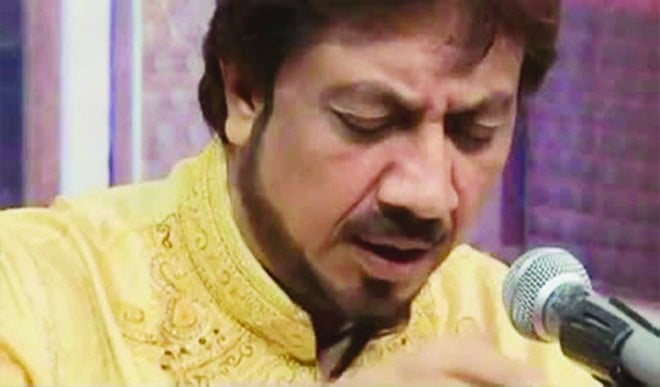
A festival in Lahore was dedicated to the great contribution made to ghazal gaiki of Mehdi Hasan

As part of the festivities to celebrate bahar (spring), a two day Ghazal Festival was held at the Alhamra Arts Council Lahore. It was dedicated to, and rightly so, to the great contribution made to ghazal gaiki by Mehdi Hasan.
The participants included Ustad Hamid Ali Khan, Ghulam Abbas, Saira Naseem, Asif Javed, Shifaat Awan, Nida Faiz, Saima Jahan, Sara Raza Khan, Ejaz Qaiser and Rauf Khan.
As one listened to the performances of the various front rank ghazal gaiks during the course of sessions spread over two days, it appeared that certain of the ghazal gaiks like Farida Khanum, Begum Akhter, Iqbal Bano and Mehdi Hasan had taken ghazal gaiki to a definitive high point which is probably very difficult to surpass in the current phase of music.
During the course of the twentieth century, ghazal was still considered a minor form of singing. The reputable ustads specialising in kheyal and even thumri or dadra did not stoop to sing the ghazal on public occasions. They took great pride in the high classical tradition and refused to venture beyond the genre of the semi or the light classical.
Gradually, with the fading away of the princely states in Pakistan and their instant abolition in India, high classical tradition suffered a setback and pushed the artistes into seeking recognition in popular forms of music. In Pakistan, ghazal was the first to occupy the position vacated by kheyal and went from strength to strength in the decades following partition.
Ustad Hamid Ali Khan, like other Patiala Gharana vocalists, has worked on his versatility. In the previous generation, the vocalists of the gharana, also focused on thumri and kafi apart from kheyal. With the changing taste in music, great vocalists like Ustad Barkat Ali Khan and Ustad Amanat Ali Khan started to sing the ghazal as well. Mubarak Ali Khan, the brother of Bare Ghulam Ali and Barkat Ali also ventured into films.
Ustad Hamid Ali Khan’s sons have opted to sing in the contemporary style and mix it with what in generic terms is labelled as pop music. Before them, Shafqat Amanat Ali Khan too ventured into the world of popular music.
There was a twenty year old age gap between Hamid Ali Khan and his elder brothers, Ustad Amanat Ali Khan and Fateh Ali Khan. They were able to sustain their high classical kheyal gaiki as it was heard extensively in East Pakistan. Their trip to that part of Pakistan guaranteed that they could devote enough time and creative energies and live in relative comfort on the basis of their classical music performances. But with East Pakistan becoming Bangladesh, that important link was severed.
Amanat Ali Khan, in particular, ventured more into popular forms like ghazal/geet, both film and non-films. With his death in his prime, Hamid Ali Khan had fewer options. He teamed up with Asad Amanat Ali Khan and the duo experimented given the realities of changing taste in music. He actually was the product of the new Pakistan while the formative years of his brothers were spent in colonial India and their performing years in united Pakistan.
Hamid Ali Khan can sing any form of vocal music and while this may be a plus factor it also points towards lack of specialisation. Once he is on stage to perform, for example, if it happens to be a ghazal festival he will be requested to sing geets, film songs, songs sung in teleplays. In all forms of his singing, it is evident that the basic training that he received was in the classical tradition and carries the same intonation into his other forms of singing.
While this could be said of most of the gaiks even during the course of the twentieth century, it cannot be said with confidence now about the current crop of singers.
Ghazal in the earlier phase was sung more like a geet. Many of the early singers felt obliged to weave the metrical pattern of the ghazal into the rhythmic scheme of the composition. Since ghazal was popular in the salons of dancing girls, the musical form too developed as subservient to the complexities of dance.
Many of the ghazals of the middle phase were mere adjuncts to the entire ethos of dance. This mujrai ang was again an inhibiting variable in the growth of ghazal as an autonomous form of music. Ustad Barkat Ali Khan was successful in liberating the musical form from the metrical design of poetry and infused it with the freedom of thumri gaiki without losing the thread of the poetical content altogether.
The influences of the various ustads were evident in the rendition of the ghazal during the sessions of the festival. Saima Jehan and Saira Naseem are obviously influenced by Noor Jehan and they apply their notes with full-throated ease and throw their voices so as to be more engaging in the upper register. The influence of Noor Jehan in many ways is inescapable. Ghulam Abbas is a shagird of Mehdi Hasan and his ang and intonation is clearly a true reflection of that while Asif Javed too falls in the same mould.
Mehdi Hasan developed a completely new style of singing. Since he was from Rajasthan, he brought with him the ang of the very rich tradition of the Jaipur gaiki. By integrating the maand -- a folk form -- he created an ang which was rendered with a constricted throat that went along wonderfully well with the recording and microphone’s technological limitations as the very fine and subtle nuances were captured.
His forebears were well known musicians and had been associated with the numerous courts of the states in what is now Rajasthan. His father Azeem Khan and uncle Ismail Khan too were court singers and he was trained by them but the most definitive influence was that of his elder brother Pandit Ghulam Qadir.